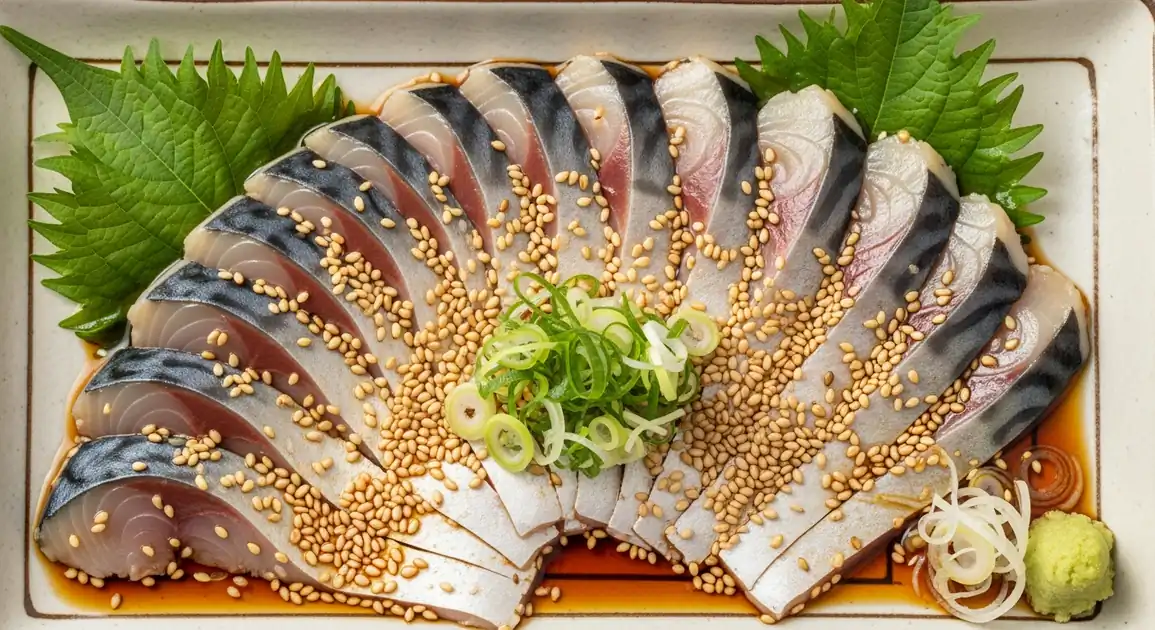Goma Saba (Sesame Mackerel)
ごま鯖 (Goma Saba)

Description
Fukuoka, a coastal city in Kyushu, is renowned for its exceptional seafood and is considered one of the premier destinations for goma saba in Japan. The city's proximity to rich fishing grounds ensures remarkably fresh mackerel, while its culinary tradition emphasizes clean flavors that allow the quality of the fish to shine through.
Dietary Information
Serving information
Serving style
In Fukuoka, goma saba is often served on distinctive Arita or Karatsu ceramics. Accompanying condiments typically include fresh wasabi, grated ginger, and sometimes a specialized citrus-soy blend specific to the restaurant.
Quick facts
Fish market restaurants: 7 AM - 2 PM. Regular restaurants: 11 AM - 2 PM, 5 PM - 10 PM. Izakayas: 5 PM - 12 AM. Yatai stalls: 6 PM - 2 AM.
Safety Tips
What to Look For
-
Establishment specializes in seafood or specifically mackerel dishes
Restaurants with a focus on seafood typically have better sourcing, handling, and preparation techniques for raw fish.
-
Fish is prepared to order or very recently
Due to mackerel's high oil content, it spoils quickly. Fresh preparation is essential for both safety and flavor.
-
Mackerel has clear, bright eyes and firm flesh (if you can see it being prepared)
These are universal indicators of fresh fish. Dull, sunken eyes or mushy flesh indicate older fish not suitable for raw consumption.
-
Thin slices rather than thick chunks
Proper slicing increases surface area exposure to vinegar treatments and makes visual inspection of quality easier.
-
Restaurant is busy with good turnover
High turnover ensures fresh supplies and reduces the time fish spends in storage.
What to avoid
-
Strong fishy smell or ammonia odor
Fresh mackerel should have minimal oceanic aroma. Any strong fishy or chemical smell indicates decomposition has begun.
-
Dull, brownish color or dried edges on the fish
Fresh mackerel slices should be translucent with a clean sheen. Discoloration indicates oxidation and aging.
-
Pre-prepared goma saba sitting in display cases for unknown periods
This dish should ideally be prepared shortly before consumption, not left sitting for extended periods.
-
Restaurants with limited refrigeration or poor temperature control
Proper cold chain maintenance is essential for raw fish safety.
-
Restaurants that seem to have very low customer traffic
Low turnover may mean fish isn't being replaced frequently enough for optimal freshness.
Price information
Price range
Budget tips
- Yatai (street food stalls) sometimes offer simpler versions for 700-1000 JPY.
- Local izakayas in residential neighborhoods like Hakozaki or Nishijin offer better value than tourist-oriented places.
- Lunch specials at seafood restaurants near Nagahama Fish Market can be excellent value.
- Consider ordering as part of a teishoku (set meal) rather than à la carte for better value.
Value indicators
- Fish that's demonstrably local and fresh-caught.
- Hand-sliced to order rather than pre-prepared.
- Properly seasoned and freshly toasted sesame seeds.
- Appropriate accompaniments including fresh wasabi (not the reconstituted paste).
- Traditional ceramic serving vessels indicating attention to presentation.
Where to Find This Dish
Nagahama Fish Market Area
Known for ultra-fresh seafood, with restaurants serving fish purchased that morning.
Nagahama Fish Market, Chikuzen Nagahama Station
Morning, Early Afternoon
Tenjin
The downtown core features numerous high-end izakayas and seafood specialists.
Tenjin Underground Shopping Center, Mitsukoshi Department Store
Evening
Hakata Station Area
Convenient cluster of restaurants, including several specializing in local Kyushu cuisine.
JR Hakata Station, Hakata Bus Terminal
Lunch, Dinner
Vendor Tips
- Restaurants displaying the '福岡の魚' (Fukuoka Fish) certification prioritize local catches.
- Ask if the mackerel is 'genba-mono' (locally caught) for the freshest experience.
- Some places offer 'zenkoku-ichi' or 'ichiban' preparation - meaning their own special preparation they're proud of.
How to Order
Regional Variations
-
Fukuoka-style Goma Saba
(博多風ごま鯖)
Often features a more generous application of sesame seeds than versions in other regions, and may incorporate local yuzu or sudachi citrus in the sauce.
-
Genkai Sea Mackerel Special
(玄界灘鯖の特選)
Premium version using specifically mackerel from the Genkai Sea, known for its exceptional quality and flavor.
-
Mentaiko-infused Goma Saba
(明太子入りごま鯖)
A Fukuoka specialty that incorporates spicy mentaiko (pollock roe) - another local specialty - into the sesame coating or sauce.
-
Hakata Yatai Style
(博多屋台風)
Simplified but flavorful preparation found at street food stalls, often with a more pronounced vinegar flavor to ensure safety.
Cultural context
History
Goma Saba originated in the Kyushu region, particularly around Fukuoka, where fresh mackerel has been historically abundant. The dish represents the Japanese culinary philosophy of highlighting seasonal, local ingredients with minimal intervention. The addition of sesame seeds was a practical enhancement that not only added flavor but helped preserve the highly perishable fish before modern refrigeration. It evolved from simple fishermen's fare to a respected izakaya and restaurant dish throughout Japan.
Local significance
Fukuoka's proximity to Korea and historic role as a gateway for foreign influence has shaped its culinary identity, including its seafood preparations. Goma saba reflects the region's emphasis on fresh, high-quality ingredients prepared simply to highlight natural flavors.
Eating customs
- In Fukuoka, it's common to enjoy goma saba as a starter before moving on to heartier dishes like ramen.
- Local custom sometimes includes a small cup of green tea between seafood courses to cleanse the palate.